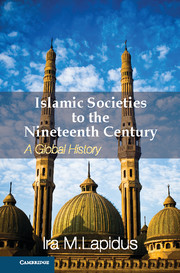Book contents
- Frontmatter
- Contents
- List of Illustrations
- List of Figures
- List of Maps
- List of Tables
- Preface
- Acknowledgments
- Acknowledgments to the first edition of A History of Islamic Societies
- Acknowledgments to the second edition of A History of Islamic Societies
- Publisher's Preface
- Introduction to Islamic Societies
- Part I The Beginnings of Islamic Civilizations
- Part II From Islamic Community to Islamic Society
- Part III The Global Expansion of Islam from the Seventh to the Nineteenth Centuries
- Chapter 25 Introduction: Islamic Institutions
- The Western Islamic Societies
- Islam in Asia
- Islam in Africa
- Chapter 39 The African Context: Islam, Slavery, and Colonialism
- Chapter 40 Islam in Sudanic, Savannah, and Forest West Africa
- Chapter 41 The West African Jihads
- Chapter 42 Islam in East Africa and the European Colonial Empires
- Conclusion
- Glossary
- Bibliography
- Annotated Bibliography from A History of Islamic Societies, 2nd Edition
- Index
Chapter 39 - The African Context: Islam, Slavery, and Colonialism
Published online by Cambridge University Press: 05 February 2013
- Frontmatter
- Contents
- List of Illustrations
- List of Figures
- List of Maps
- List of Tables
- Preface
- Acknowledgments
- Acknowledgments to the first edition of A History of Islamic Societies
- Acknowledgments to the second edition of A History of Islamic Societies
- Publisher's Preface
- Introduction to Islamic Societies
- Part I The Beginnings of Islamic Civilizations
- Part II From Islamic Community to Islamic Society
- Part III The Global Expansion of Islam from the Seventh to the Nineteenth Centuries
- Chapter 25 Introduction: Islamic Institutions
- The Western Islamic Societies
- Islam in Asia
- Islam in Africa
- Chapter 39 The African Context: Islam, Slavery, and Colonialism
- Chapter 40 Islam in Sudanic, Savannah, and Forest West Africa
- Chapter 41 The West African Jihads
- Chapter 42 Islam in East Africa and the European Colonial Empires
- Conclusion
- Glossary
- Bibliography
- Annotated Bibliography from A History of Islamic Societies, 2nd Edition
- Index
Summary
The history of Islam in the African continent falls into three geographical and historical zones. The Mediterranean littoral was conquered by Arab-Muslims and later by the Ottoman Empire and was a region of Arab-Islamic culture. West Africa, including the Sahara desert, and the savannah, forest, and coastal country south of the Sahara constituted a second region. Coastal East Africa and its hinterlands, including inland savannah country, was the third. The history of Islam in North Africa appears in conjunction with the history of the early Arab-Islamic conquests and the Ottoman Empire. However, the history of Islam in Africa cannot be separated from the interactions between Africa and the outside Muslim world, nor from its varied connections to Europe.
Islam
Three themes define pan-African history. The first is Islam. The Islamic period in Africa began in the seventh century with contacts among the newly founded Arab-Islamic empire and sub-Saharan and coastal East Africa. Whereas Islamic societies in the Middle East and the Indian subcontinent were established by conquest and ordered by states, Islam in Africa, as in Indonesia, was diffused primarily by the migration of Muslim merchants, teachers, and settlers.
- Type
- Chapter
- Information
- Islamic Societies to the Nineteenth CenturyA Global History, pp. 581 - 587Publisher: Cambridge University PressPrint publication year: 2012



